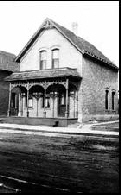During our recent trip to Minneapolis, we went out one evening to meet some of Rob’s friends and took a brief detour through historic Milwaukee Avenue in the Seward neighborhood.
The homes along this wide avenue were built between 1884 and 1890 by William Ragan, a Minneapolis real estate speculator. The homes were intended for low-income families, who were mostly Scandinavian immigrants, and were constructed on small, narrow lots that have virtually no front yards and tiny side yards. The road was originally platted as an alley and since it bisects 22nd and 23rd Avenues, it was originally called – get this – 22 1/2 Avenue! Below is a photo from the Minneapolis Historical Society.
The street kept it’s ½ designation until 1906, when petitioners asked the Minneapolis City Council to change the name to Woodland Avenue. They said the ½ made them feel like they lived in an alley. But instead of changing the name to Woodland, the council changed it to Milwaukee Avenue, perhaps because of its proximity to the Milwaukee Short Line Railroad.
The houses were built from brick veneer on timber frames. They were neglected during the Great Depression and WWII and by the end of the war, had deteriorated badly. In 1959, the city listed the houses on Milwaukee Avenue as such, a designation that meant they had no indoor plumbing or were severely battered. In 1970, the city planned to demolish the houses and raze the neighborhood.
However, many of the residents were seasoned protestors from the Vietnam War era and they formed the Seward West Project Area Committee (PAC) in an attempt to save it. They argued that the houses had significant historic value and should be preserved. But the city contended that it would cost more to refurbish the houses than to build new ones.
So these former Vietnam protestors pulled a slick one. They secretly submitted an application to the National Registry of Historic Places for the Milwaukee Avenue district. It was approved by the U.S. Secretary of the Interior on May 2, 1974. It meant the city couldn’t alter or destroy the houses using federal funds without a public hearing.
Even so, nine of the Milwaukee Avenue houses had to be destroyed because they were in such terrible condition and a tenth was moved elsewhere. The rest of the houses got big makeovers – indoor plumbing, new basements, improved woodwork and porches. A pedestrian mall was built down the avenue to replace the street. No cars are allowed – just bikes and pedestrians.
As Rob and I were walking, some residents were sitting out on their front porches and others were involved in a community project – laying down mulch around the many trees on the avenue. This beautiful avenue is a striking example of what can happen when a group of people who are passionate about something can bring about change.











What a great place. Though we can’t live in the past we can still protect some of the essence of the period – much better than destroying and losing it forever. As Shadow says – A Good News Story.
What a great story! It makes me feel all warm and fuzzy inside and gives me a realization that anything is possible if we put our minds to it. 🙂
🙂
Whenever I get to Minneapolis, I always take a walk along Milwaukee Ave. before tipping a couple of brews at Tracy’s, located near the end of the avenue.
At last, a good news story, thank you!
It IS a good new story!